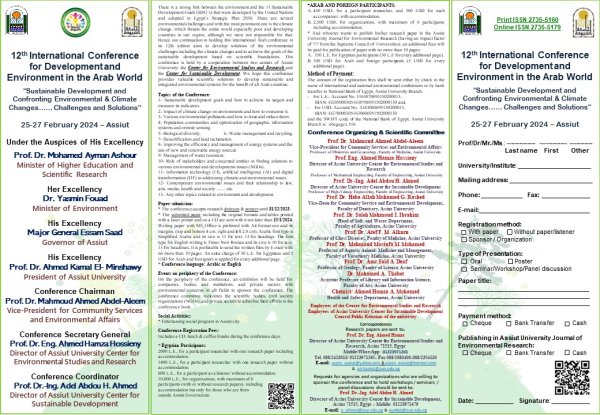Conference Link
https://www.aun.edu.eg/env_units/en/icdeaw

Lead sulfide nanoparticles were hydrothermally synthesized
and their size was diminished via exposure to ultrasound
waves. Both h-PbS and h,us-PbS nanoparticles of
different sizes were characterized using powder X-ray
diffraction, TEM microscopy and surface area measurements.
The nanoparticles limited the growth of Aspergillus
pathogens and light microscopy proved severe morphological
abnormalities in the fungal vesicles, conidiophores and
mycelia in response to the nanoparticles.
The introduction of fish skin as a biological dressing for treating burns and wounds holds great
promise, offering an alternative to existing management strategies. However, the risk of disease
transmission is a significant concern. Therefore, this study aimed to examine how established
sterilization and preservation procedures affected fish skin grafts’ microbiological and histological
properties for long‑term usage. Lyophilization of the fish skin graft followed by rehydration in
normal saline for 15 min did not change the collagen content. Furthermore, gamma irradiation of
the lyophilized fish skin graft at different lengths 5, 10, and 25 KGy showed a significant reduction in
microbial growth (aerobic bacteria, aerobic yeasts, and fungi) at 15‑ and 30 days after the irradiation.
However, exposure to 10 KGy was found to be the most effective intensity among the different
gamma irradiation lengths since it preserved the collagen fiber content and intensity in the lyophilized
fish skin grafts at 15‑ and 30 days after the irradiation. These findings provide efficient preservation
and sterilization methods for long‑term usage of the fresh Tilapia skin grafts used for biological
dressings.
Heterocyclic moieties, such as benzimidazole, are examples of important nuclei that have found widespread use in a variety of scientific subfields, such as medical and applied chemistry. In this study, we described the photocatalytic synthesis of numerous different benzimidazole derivatives using a solid-state acid composed of zirconium oxosulfate embedded into carbon (ZrOSO4@C). A metal-organic framework (MOF), known as UiO-66, was used as a precursor for the synthesis of ZrOSO4@C via carbonization in the presence of sulfuric acid. ZrOSO4@C was able to catalyze the reaction effectively, allowing for a condensation and cyclization to take place in a single vessel, which resulted in a high yield (77–98%) of benzimidazoles that were of high purity with the byproducts of water, and hydrogen (H2) gas. Our catalyst allowed for an improvement in the synthesis of many different benzimidazole derivatives by …
The present paper aims to use natural biodegradable polymers of chitosan (CS) and cellulose (CEL) to synthesize green chitosan-cellulose (CS-CEL) nanocomposite as a new clarifying agent. This is the cutting-edge of the sugar industry's clarification process. The CS-CEL nanocomposite showed outstanding results in zeta potential analysis, with a maximum value (+) 57.73 mV, leading to remarkable results in color adsorption via electrostatic attraction. It was also observed that CS-CEL has high mechanical stability. When CS and CS-CEL nanocomposite were used in the clarification of sugarcane (MJ), the findings demonstrated an improvement in color removal of up to 8.7% using CS and 18.1% using CS-CEL nanocomposite compared to currently phosphotation clarification process. Also, Turbidity decreased using CS-CEL nanocomposite compared to the traditional phosphotation clarification process. Overall …
Nanomaterials (NMs) have distinctive physicochemical characteristics and offer adaptable scaffolds for biomolecule functionalization. NMs have such a wide range of properties and use that a general evaluation of their health and environmental concerns is impossible. A necessary component of sustainable development is the application of nanotechnology (NT) research in the agricultural sector. The green revolution and new farming techniques have significantly increased crop yield but gradually reduced soil micronutrients, including Zn, Mo, and Fe. It is possible to employ NT to increase the availability of micronutrients for plants. The significant interests of using NT in agriculture include specific applications like nano-fertilizers and nano-pesticides to trail products and nutrient levels to increase productivity without contamination of soils and waters and protection against several insect pests and microbial …
Carbon dots (CDs) with small particles less than 10 nm offered unique electrochemical properties. They can be synthesized via various methods using abundant carbon sources. The electrochemical properties of CDs can be optimized via several strategies, including doping with heteroatoms, optimizing the synthesis conditions, and postsynthetic procedures. CDs can be used as suitable electron transporters. They exhibit several advantages, such as a large surface area that offers simple electrode fabrication and enables a high contact area with the investigated analyte. The electrochemical properties of CDs have advanced the analysis of different analytes, including heavy metals ions, biomarkers, hydrogen peroxide, drugs, and other species. The functional groups of CDs provided strong interactions with the vast number of analytes promoting direct electron transfer. CDs offered high sensitivity, good selectivity, and promising properties for analyzing real samples.
Carbon dots (CDs) have been used as a fluorescence probe to sense heavy metal ions. They can be synthesized using cheap sources and offer good optical properties. They provide good photoluminescence properties. The fluorescence emission of CDs can be tuned by controlling particle size, selecting suitable excitation wavelength, and changing the chemical composition via doping with heteroatoms. The synthesis procedure can also affect the optical properties of the synthesized CDs. The unique optical emission enables the sensing of heavy metals, including biological heavy metals (e.g., Fe3+, Zn2+, Cu2+) and toxic metals (e.g., Pb2+, As3+, Ag+, ClO−). CDs as fluorescence probes enable a low detection limit and a good linear relationship for a wide concentration range. They can be applied for actual samples with promising properties for assembling electronic devices. This book chapter summarizes the applications of CDs as fluorescence probes to detect heavy metal ions.

